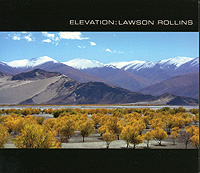 Following
the release of his first two solo albums, guitarist Lawson Rollins
has assembled what could be considered his definitive musical
statement to date with the 2011 CD release of Elevation.
There’s no shortage of gifted nuevo flamenco and nylon string
guitar virtuosos recording today, yet Lawson manages to keep a fresh
perspective on the 13 track Elevation—adding
in elements of jazz-rock fusion and World Beat sounds throughout what
sounds on the surface to be a nuevo flamenco guitar album. As is the
case with Elevation, listening to a new Lawson Rollins CD is
a ritual unto itself—from
the sumptuous palate of guitar sounds and the
gifted musicians recording with him
down
to the first
rate CD mastering and
the meticulous care behind the album art and packaging. Among the
players backing up Rollins here are key musicians including Dominic
Camardella (keyboards), Shahin Shahida (electric guitar),
avant rock guitarist Buckethead, long time Rollins side men—the
rhythm section of Dave Bryant (drums) and Randy Tico (bass)
and a whole lot more. One of the great instrumental guitar albums
of 2011, Elevation also proves to be Lawson’s most guitar-centric
album yet. It’s a testament to Rollins that he’s able to
bring together and record with such a wide range of players—representing
musical styles and concepts from far and wide—while
producing such a fine consistency of ornate sounding instrumental
guitar based tracks. With Elevation, Lawson Rollins turns in
a masterpiece of high guitar art. www.LawsonRollins.com
Following
the release of his first two solo albums, guitarist Lawson Rollins
has assembled what could be considered his definitive musical
statement to date with the 2011 CD release of Elevation.
There’s no shortage of gifted nuevo flamenco and nylon string
guitar virtuosos recording today, yet Lawson manages to keep a fresh
perspective on the 13 track Elevation—adding
in elements of jazz-rock fusion and World Beat sounds throughout what
sounds on the surface to be a nuevo flamenco guitar album. As is the
case with Elevation, listening to a new Lawson Rollins CD is
a ritual unto itself—from
the sumptuous palate of guitar sounds and the
gifted musicians recording with him
down
to the first
rate CD mastering and
the meticulous care behind the album art and packaging. Among the
players backing up Rollins here are key musicians including Dominic
Camardella (keyboards), Shahin Shahida (electric guitar),
avant rock guitarist Buckethead, long time Rollins side men—the
rhythm section of Dave Bryant (drums) and Randy Tico (bass)
and a whole lot more. One of the great instrumental guitar albums
of 2011, Elevation also proves to be Lawson’s most guitar-centric
album yet. It’s a testament to Rollins that he’s able to
bring together and record with such a wide range of players—representing
musical styles and concepts from far and wide—while
producing such a fine consistency of ornate sounding instrumental
guitar based tracks. With Elevation, Lawson Rollins turns in
a masterpiece of high guitar art. www.LawsonRollins.com
mwe3.com
presents an interview with
LAWSON ROLLINS
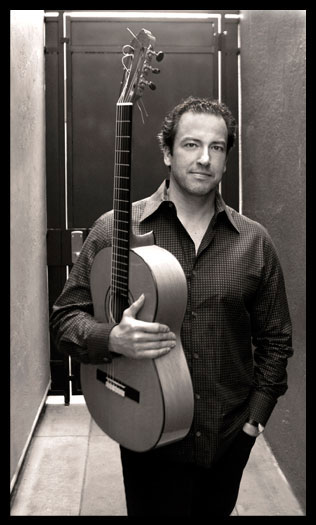 mwe3:
Congratulations on the new Elevation album. It sounds like
a guitar lovers dream come true! To my ears, it seems like the guitar
sounds are much more present in the mix and there’s some great
guitar sounds and textures from you, Shahin and Buckethead on the
new Elevation album. How would you describe the chemistry between
you, Shahin, Buckethead and Jim Hoke on guitars and what other musicians
were key to the album success?
mwe3:
Congratulations on the new Elevation album. It sounds like
a guitar lovers dream come true! To my ears, it seems like the guitar
sounds are much more present in the mix and there’s some great
guitar sounds and textures from you, Shahin and Buckethead on the
new Elevation album. How would you describe the chemistry between
you, Shahin, Buckethead and Jim Hoke on guitars and what other musicians
were key to the album success?
LAWSON ROLLINS: We have 20 different musicians on the album,
recorded in Iran, Nepal, and the U.S., and meshing all the performances
into a cohesive whole was definitely exciting and challenging. The
key to successfully combining all these multiple styles is finding
musicians at the top of their field who share an enthusiasm for what
you are trying to accomplish musically. When you work with people
you respect and trust you know they are going to find the best way
to fit into the songs and you let them do their thing. Working with
Shahin Shahida, Buckethead, and Jim Hoke was effortless and a pure
pleasure, as was the collaboration process with the other guest artists.
Typically, I have all of my guitar parts completed before I present
the songs to the musicians. The structure of the song, the main melodies,
etc., are all there for the musicians to create and improvise on top
of. Of course, I leave myself the option to go in and reshape my own
parts when needed, but generally I have a vision of how the songs
should sound and it’s then a matter of picking the right musician
to bring aboard. For example, with the song “Daybreak” I
kept hearing pedal steel guitar meshing with the cello, so we connected
with Jim Hoke in Nashville who really delivered the goods. Same with
Buckethead—two songs called for the incendiary lead guitar work
he is known for and he delivered stellar performances on “Ghosts
of Alcazar” and “Slow Ascent”. He was gracious enough
to do a 20 second cameo on a third track, the title song “Elevation”,
that really called for a soaring electric guitar melody. I had recorded
my own version on a PRS electric guitar and just couldn’t get
what I needed, so Bucket came to the rescue. My go-to violinist, Grammy-winner
Charlie Bisharat, is another guy you can count on to deliver just
what a song calls for. You can hear his lush string section arrangements
all over the album, along with his virtuoso lead violin. Once you
find the right ingredient—the right musician, that is—things
fall into place naturally and easily and the chemistry is infectious
with everyone on board the project.
mwe3: How would you compare the sound and musical direction of the
new Elevation album with your first two solo albums Infinita
from 2008 and Espirito from 2010? What were you
striving towards musically and compositionally on the Elevation
album?
LR: Coming off Espirito it really was a challenge to decide
what direction to go in next, but when I wrote the title track "Elevation"
early on in the process of making the new album, a direction emerged—to
make the music as emotionally intense as possible and create room
for the songs to build and grow in more of a cinematic fashion rather
than adhere to the tighter song structure I had previously been working
within. I refer to the songs in "Elevation" as “soundscapes”
that are meant to take the listener on an emotional, musical journey
over the course of the 74 minutes of music. I assembled the widely
eclectic ensemble of musicians for "Elevation" to add to
the dramatic effect, including some wonderful musicians recorded in
Nepal and Iran. Together, we infuse each track with moments of intensity
that elevate the music to emotionally-charged high-points, followed
by periods of spaciousness and calm. The concern was more with conveying
a feeling and mood rather than a catchy melody, and this became a
motif throughout the entire album. I suppose Elevation could
be described as more ‘cinematic’ than my past releases.
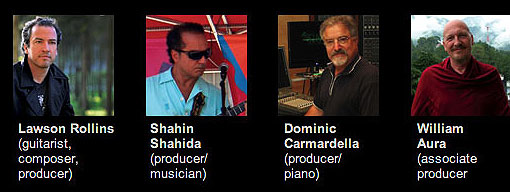 mwe3:
What did Shahin and Dominic Camardella bring to the table as co-producers
this time with you? How did you meet those two players and how about
William Aura? Now there’s a guy who was a key element to the
success of New Age music back in the late 1980’s.
mwe3:
What did Shahin and Dominic Camardella bring to the table as co-producers
this time with you? How did you meet those two players and how about
William Aura? Now there’s a guy who was a key element to the
success of New Age music back in the late 1980’s.
LR: Several of the key players on the album are people I worked with
on past projects, such as Persian-American musician Shahin Shahida
of Shahin & Sepehr fame, Dominic Camardella, a veteran producer
of such artists as Flora Purim and Ottmar Liebert, and Grammy winning
violinist Charlie Bisharat. But for the new project we went farther
afield and organized some recording sessions in Nepal with my friend
William Aura of 3rd Force who works in Nepal regularly, and also in
Iran through my co-producer Shahin, who is originally from Iran. The
Nepali musicians brought an almost otherworldly sound to the mix through
their performances on the Himalayan flute, tabla, and sarangi—a
kind of fiddle instrument with an aching beauty to it. In Iran, Shahin
was also able to record a santur virtuoso and a famous Iranian vocalist
while he was there during the summer uprisings of 2010. Something
about that tumultuous time in Iran came through in the intensity of
the performances.
mwe3: Where did you record Elevation and how did you approach
this album in the studio? For instance did you use a lot of overdubs
or mostly live takes. Did you use ProTools when you record and what
else was involved in the recording process?
LR: As I mentioned, we recorded several musicians in Nepal and Iran
for the album, so a lot of what we did was editing the musical material
captured in these far-flung locales after the fact, picking the best
takes, and meshing them into the album. With language barriers, and
not always being face-to-face, sometimes it’s best to just let
the musicians take several improvisational passes at the tracks, then
sort it out later in editing. ProTools really helps with this. The
primary recording, editing, and mixing occurred at Santa Barbara Sound
Design, owned by co-producer Dominic Camardella. He is one of the
best engineers when it comes to recording nylon string guitar and
I have done my last 3 albums with him. He uses ProTools HD and a state-of-the-art
Rupert Neve 5088 analogue console, which returns some of the warmth
of analogue to the digital universe. Of course he also has a full
arsenal of vintage Neve pre-amps and an assortment of vintage microphones
that bring warmth to the guitar tones. So we recorded the guitars
in Santa Barbara along with several of the Los Angeles based musicians,
like violinist Charlie Bisharat, and then we imported the material
recorded abroad into the ProTools sessions and spent hours combing
through what we had to work with to find the choice parts.
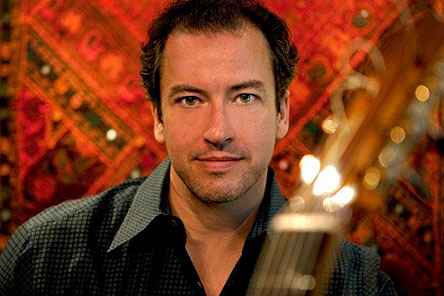 mwe3:
What does mastering an album have to do with its final sound on CD?
I know you put a lot into the Elevation mastering process and
it sounds like it. Also who pressed the Elevation CD?
mwe3:
What does mastering an album have to do with its final sound on CD?
I know you put a lot into the Elevation mastering process and
it sounds like it. Also who pressed the Elevation CD?
LR: Mastering is a crucial step that can make the difference between
an album sounding bland and sonically undefined or one that is sparkling,
dynamic, and crystal clear. We used Gavin Lurssen in Los Angeles for
Elevation and he really did a find job of bringing clarity
to these massive tracks that have so many layers of instrumentation.
The CDs were pressed by the ever-reliable plant, Rainbo Records.
mwe3: I know you’re featuring, in addition to the CD, a special
hi-resolution download of the Elevation album. Can you say
something about the future of downloads and CD as an art form too?
How many different places can you buy the Elevation CD and
also download the CD or tracks from the CD?
LR: I am not thrilled with the sound quality of the average download
service or the streaming services, though I admit I use these technologies
everyday and love them for the sheer convenience and unlimited access
to recorded music they offer the user. But highly compressed music
files are the equivalent of going into an art museum and looking at
a fine painting with a film of wax paper covering it. That is what
compression does to music—it clouds the detail. With acoustic
instrumental music like mine, this is really a problem. My hope is
that technology will continue to improve the resolution of music downloads
and make high resolution files the default format. Currently, you
can purchase my music on Amazon.com and all the conventional download
and streaming sites, but if you want to get a taste of true high resolution
downloads, go to LinnRecords.com where you can find my music—and
a growing roster of other artists—in 24-bit/88.2Khz detail, which
is much better than even CDs. A track you might purchase from iTunes
that is 7 megabytes in size suddenly becomes a 150 megabyte file on
Linn Records and the difference in audible detail is profound.
mwe3: Can you say something about the cool Elevation art work?
How do you choose your album titles and how about choosing Elevation
as a title this time?
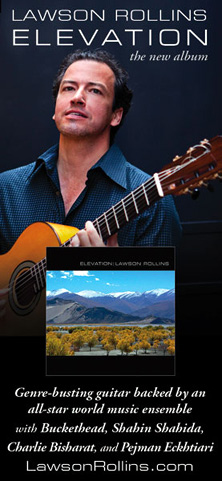 LR:
The album title came from title track “Elevation”, which
was the first song composed for the project. Once I composed and titled
that track, the rest of the album flowed out from the spirit of that
song. The concept of the particular track “Elevation” was
to elevate the intensity of the music and the emotionality of the
song during the middle section of the piece and have the musical journey
reach kind of a summit. A string section swells up during this part,
fueled by pounding taiko drums. Electric guitarist Buckethead makes
a brief appearance with a soaring melody, which is later repeated
by classical trumpeter Thomas McColl. You can hear a similar structural
motif throughout the album, particularly on tracks like “Parisian
Rhapsody”, “Slow Ascent”, and “The Diamond Path.”
LR:
The album title came from title track “Elevation”, which
was the first song composed for the project. Once I composed and titled
that track, the rest of the album flowed out from the spirit of that
song. The concept of the particular track “Elevation” was
to elevate the intensity of the music and the emotionality of the
song during the middle section of the piece and have the musical journey
reach kind of a summit. A string section swells up during this part,
fueled by pounding taiko drums. Electric guitarist Buckethead makes
a brief appearance with a soaring melody, which is later repeated
by classical trumpeter Thomas McColl. You can hear a similar structural
motif throughout the album, particularly on tracks like “Parisian
Rhapsody”, “Slow Ascent”, and “The Diamond Path.”
Deciding on an album cover was at first difficult, but when I saw
the photo of the Himalayan mountain range taken by my brother it seemed
like a logical fit—the picture is not only gorgeous, but it has
a literal connection to the Nepali musicians recorded in that part
of the world who ended up playing such a large role in the album,
while artistically the photo of the lofty peaks and ethereal blue
sky evokes the ‘elevation’ vibe I was going for in the music.
mwe3: Are you still playing and recording with the Pedro Maldonado
guitar and what other guitars do you record with on the Elevation
CD? How about your choice of guitar strings? Can you also say
something about the guitars that Shahin, Buckethead and Jim Hoke also
play on the album and will there be a Lawson Rollins signature guitar
one day?
LR: I have recorded exclusively with the Maldonado on the past three
albums. It’s totally custom to suit my needs and I love it. Recently,
though, I purchased a traditional flamenco guitar from Lester DeVoe,
who builds guitars for the likes of Paco de Lucia. It lacks the cutaway
of my Maldonado, so I wouldn’t use it much for soloing, but it’s
perfect intonation makes it ideal for melodies, harmonies, and rhythm
guitar. I look forward to using the DeVoe on my next album. I am not
sure there is enough demand for a Lawson Rollins signature model,
but I am sure Maldonado would be happy to make replicas of the one
he did for me for anyone interested. I use LaBella strings—the
2001 series classical hard tension.
Shahin uses a variety of guitars but I believe his main one on Elevation—which
you can hear to great effect on the track “Voyager’s Tale”—is
a vintage Gibson Les Paul. Buckethead
naturally uses his very own signature model Gibson.
mwe3: What kind of music are you listening to these days on CD
and how about recent favorite movies or movie soundtracks?
LR: Having had the pleasure of working with Buckethead, I have recently
enjoyed exploring his extensive and diverse catalog. He is a fountain
of creativity and truly ‘at one’ with the guitar. His album
Electric Tears that he did  with
Dominic Camardella at Santa Barbara Sound has been in heavy rotation
at my house—it’s a profound and moving work with a consistent
vibe that draws you in. I have a similar feeling about the new Terrence
Malick film Tree Of Life and its transportive, emotionally
compelling soundtrack. The original score by Alexandre Desplat, complemented
by classical works from the likes of composer John Tavener, a favorite
of mine, creates a powerful audiovisual experience.
with
Dominic Camardella at Santa Barbara Sound has been in heavy rotation
at my house—it’s a profound and moving work with a consistent
vibe that draws you in. I have a similar feeling about the new Terrence
Malick film Tree Of Life and its transportive, emotionally
compelling soundtrack. The original score by Alexandre Desplat, complemented
by classical works from the likes of composer John Tavener, a favorite
of mine, creates a powerful audiovisual experience.
mwe3: What else is set to follow for the Elevation album and
beyond?
LR: I am already embarking on the next recording project and also
plan to release some remixes of selected tracks  from
my past three solo albums—kind of a ‘best of’ but with
a new twist on the music with a focus more on highlighting the other
musicians I have worked with and their performances that sometimes
lie deep within the layers of instrumentation on the album versions
of the songs.
from
my past three solo albums—kind of a ‘best of’ but with
a new twist on the music with a focus more on highlighting the other
musicians I have worked with and their performances that sometimes
lie deep within the layers of instrumentation on the album versions
of the songs.
Thanks to Lawson Rollins @ www.LawsonRollins.com



